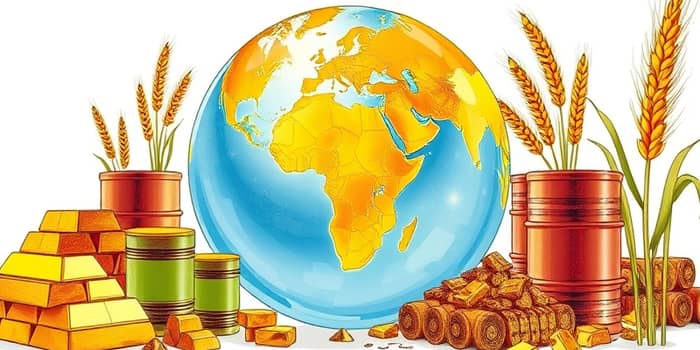
Commodity investing has surged in prominence for investors seeking to diversify portfolios and hedge against economic uncertainty. As global markets navigate inflationary pressures and shifting demand patterns, raw materials from precious metals to agricultural goods play a pivotal role.
Understanding the fundamentals of this asset class can empower investors to unlock new avenues of portfolio growth while managing the inherent risks.
Commodities refer to physical raw materials—gold, oil, silver, agricultural goods, and industrial metals—that underpin global trade and manufacturing. Historically, these assets have offered an alternative to traditional investments by behaving differently from stocks and bonds.
Since 2022, concerns over rising inflation have driven renewed interest in commodities, with investors recognizing their role as a reliable hedge during volatile economic cycles.
Investing in commodities provides several strategic advantages. First, they often exhibit a low or negative correlation with equity and fixed-income markets. Second, commodity prices tend to track inflation, helping to preserve purchasing power.
While commodities offer compelling benefits, they also present unique risks. Price swings can be extreme—often twice as volatile as equities and four times more so than bonds—requiring robust risk management.
Factors such as geopolitical events, weather patterns, and trade policies introduce complexity, making forecasting difficult for even seasoned investors.
Commodity markets have demonstrated resilience amid mixed economic signals. In 2022, the Bloomberg Commodity Index returned +16% while stocks and bonds fell, underscoring the diversification power of commodities.
As of December 2024, the US CPI stood at 2.9%, with Core CPI at 3.2%, signaling that inflation remains above the Federal Reserve’s 2% target. Looking ahead, the World Bank projects a 12% drop in commodity prices for 2025 and another 5% decline in 2026, driven primarily by excess oil supply and moderating demand.
Overall, the commodity landscape for 2025 and beyond presents a mixed picture: broad price declines are expected, but structural tailwinds in energy transition metals persist.
Gold remains the ultimate safe haven, prized for protecting wealth against currency debasement and market turmoil. Its performance strengthens during inflationary waves and geopolitical tension, making it a cornerstone in many portfolios.
Oil, the lifeblood of modern economies, drives a significant portion of commodity indices. After surging in recovery years, oil prices face headwinds from slowing global demand and rising supply, yet geopolitical flashpoints can trigger sudden price spikes.
Beyond these, industrial metals like copper are benefiting from the global energy transition and electric vehicle adoption, posting an 8% gain in 2025. Agricultural commodities, by contrast, have slipped amid abundant harvests, with grains down 5% year-to-date.
For most retail investors, accessing commodities directly is impractical. Instead, diversified vehicles offer broad exposure while smoothing sector-specific swings.
Each structure carries its own cost, complexity, and risk profile. ETFs provide liquidity and ease of trade, while futures demand margin and active oversight.
Commodities are acutely sensitive to a matrix of macro factors. Inflation data, such as CPI readings, shape market sentiment and price trajectories. A stronger US dollar typically exerts downward pressure on dollar-priced commodities.
Geopolitical events, trade regulations, and sanctions can disrupt supply chains overnight. Meanwhile, climate change and extreme weather influence agricultural yields and mining operations, adding further uncertainty to the outlook.
Commodity investing offers a distinctive combination of diversification, inflation hedging, and return potential. Yet, these benefits come with pronounced volatility and complexity, necessitating a disciplined approach.
As 2025 and beyond likely see broad commodity price declines, selective exposure to structural growth areas—such as copper and battery metals—can capture upside in the evolving global economy.
For non-specialist investors, allocating through diversified ETFs or commodity indices provides balanced participation while mitigating single-sector risks. Ultimately, a thoughtful blend of commodities within a broader portfolio can enhance resilience and fuel long-term growth.
References













